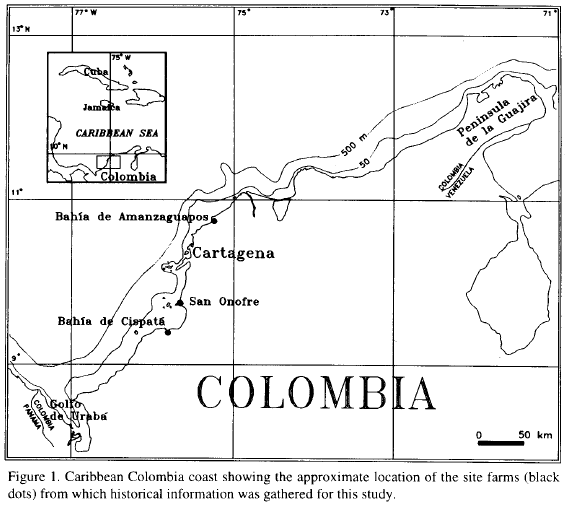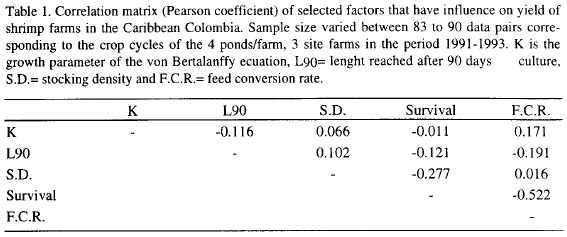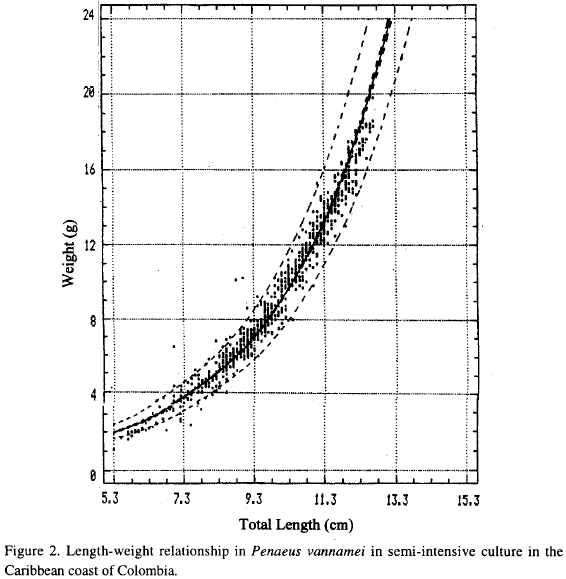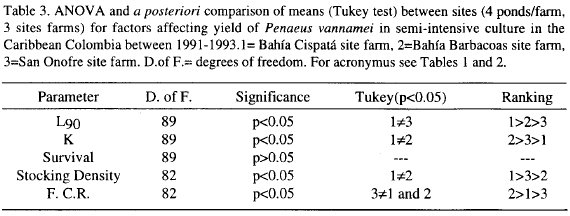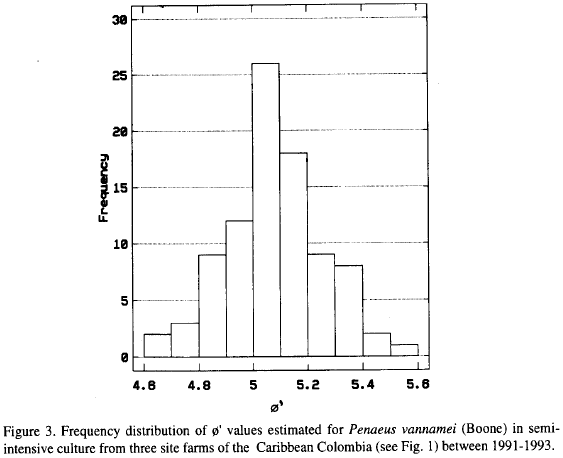Services on Demand
Journal
Article
Indicators
-
 Cited by SciELO
Cited by SciELO -
 Access statistics
Access statistics
Related links
-
 Cited by Google
Cited by Google -
 Similars in
SciELO
Similars in
SciELO -
 Similars in Google
Similars in Google
Share
Boletín de Investigaciones Marinas y Costeras - INVEMAR
Print version ISSN 0122-9761
Bol. Invest. Mar. Cost. vol.26 no.1 Santa Marta Jan./Dec. 1997
TEMPORAL AND GEOGRAPHICAL YIELD PATTERNS OF SEMI-INTENSIVE SHRIMP CULTURE (PENAEUS VANNAMEI (BOONE)) DURING THE PERIOD 1991 -1993 IN THE CARIBBEAN COLOMBIA
PATRONES TEMPORALES Y GEOGRÁFICOS DEL RENDIMIENTO DEL CULTIVO SEMI-INTENSIVO DE PENAEUS VANNAMEI (BOONE) DURANTE EL PERIODO 1991-1993 EN EL CARIBE COLOMBIANO
lovana Moreno-Amezquita1, Federico Newmark2 and Camilo B. Garcia1
1Instituto de Investigaciones Marinas y Costeras (INVEMAR), A.A. 1016, Santa Marta, Colombia (I.M.A. y C.B.G.)
2Corporación Centro de Investigaciones de la Acuicultura de Colombia, CENIACUA, A. A. 2797, Cartagena, Colombia (F.N.)
ABSTRACT
Temporal and geographical patterns of yield and selected factors affecting it: growth (von Bertalanffy K and L90: length reached after 90 days culture), survival, feed conversion rate and stocking density, were analyzed for shrimp (Penaeus vannamei) cultured in the Caribbean Colombia for the period 1991-1993. Yield did not vary between years, but it did between sites, showing the Bahía de Cispatá farm the statistically highest yield in the period considered. This pattern can be explained by the fact that shrimp there grew slowly to attain a good size, concomitantly with the highest stocking density and good feed conversion rate. In contrast, shrimp of the other sites tended to grow quicker but to stagnate at smaller sizes, stocking density tended to be lower and feed conversion rate was not so good. The growth performance index ø of P. vannamei cultured in the Caribbean Colombia were much higher than ø values of wild penaeids, but (transformed as ø') comparable with ø' values of P. vannamei cultured in Perú.
RESUMEN
Se analizaron los patrones temporales y geográficos del rendimiento del cultivo del camarón Penaeus vannamei y de factores escogidos que lo afectan: crecimiento (parámetro de crecimiento K de von Bertalanffy y L90: longitud alcanzada a los 90 días de cultivo), sobrevivencia, factor de conversión y densidad de siembra, en el Caribe colombiano durante el período 1991-1993. El rendimiento no varió entre años pero sí entre sitios, siendo la finca ubicada en la región de la Bahía de Cispatá la que presentó el rendimiento significativamente más alto. Este patrón puede ser explicado por el hecho de que el camarón en dicho sitio creció lentamente alcanzando una buena talla, concomitante con la mayor densidad de siembra y un buen factor de conversión. En contraste, el camarón de los otros sitios, si bien creció rápidamente, se estancó en tallas pequeñas, la densidad de siembra fue más baja y el factor de conversión no fue tan bueno. El índice de desempeño de crecimiento ø de P. vannamei cultivado en el Caribe colombiano es más alto que el del camarón silvestre pero (transformado a ø') comparable con los valores de ø' de P. vannamei cultivado en el Perú.
INTRODUCTION
Considerable expansion in shrimp culture industry has occurred in Colombia in recent years. Commercial shrimp culture operations, however, date back to 1983. Production results mainly from Penaeus vannamei culture with a minor contribution from P. stylirostris and P. schmitti both in the Caribbean and the Pacific coasts of Colombia. The most common culture strategy is semi-intensive. However, several small and some larger farms, employed semi-extensive methods during their start-up phase.
Colombia produced (Caribbean plus Pacific coast), 6717 metric ton in 1991, 9432 m.t. in 1992 and 7326 m.t. in 1993 (INPA, 1994). Newmark et al., (1993), reported a mean production of 1386 kg/ha/crop for Caribbean Colombia in 1991, and Weidner and Rosenberry (1992), for the same year, report a national average of 3380 kg/ha/year, which is higher than the figures reported for other American countries with the same species in the same year, for instance, Ecuador (910 Kg/ha), Peru (2620 kg/ha) and Honduras (1133 kg/ha) (Weidner and Rosenberry, 1992).
According to Weidner (1991), who based this statement on a personal communication (Henry Clifford, Tropical Mariculture Technology; in Weidner, 1991), the high production in the Caribbean Colombia is a result of high growth rates. However, to our knowledge, data on growth rates of Penaeus vannamei during culture cycles in the Caribbean Colombia are nonexistent or not reported in the literature. No attempt of analyzing historical data on yield patterns and factors associated has been made, either, to our knowledge, at least in the scientific literature.
There is in consequence a need for more rigorous analysis and systematic presentation of data that should help in the construction of a more accurate picture of this very important economic activity. Thus, the objectives of this work are (1) to describe historical patterns (the period 1991-1993) of shrimp yield and some selected factors (see below), (2) to explore the relationships between yield and those factors which include the von Bertalanffy growth parameters of Penaeus vannamei, stocking density, survival and feed conversion rate, and (3) to determine whether there were geographical differences in yield and the selected factors in the Caribbean Colombia.
MATERIALS AND METHODS
Study Area
The three study sites on the Caribbean cost of Colombia selected for this study, are shown in Figure 1. The first site, the Bahía de Cispata, is characterized by areas of mangrove forest and sand surrounded by dry and semi-dry forest formations. It is influenced by the Sinu river system, which is called the white" river due to its high transport of sediments and nutrients in the rainy season. The second site, the San Onofre municipality, is an arid eolic plane covered with dry and semi-dry forest. The third site, the Bahía de Barbacoas (Covado Island), is estuarine in character due to the influence of the Dique channel (Magdalena River system) with a well established and developed mangrove forest. This area is also very much influenced by human activities. (CORPESC.A., 1992).
There are two main climatic seasons in the region: the rainy season from May to November and the dry season from December to April, approximately. Newmark et al., (1993) report an average pond water temperature and salinity in a sample of 7 farms across the Caribbean Colombia in the 1989-1992 period of approximately 30°C and 20, respectively, in the rainy season, and 29°C and 32 respectively, in the dry season.
Data Collection
One farm was selected for each site. Historical data from 4 ponds per farm including stocking density (number of larvae per m2), survivorship (number of survivors at yield against number of larvae at stoking in percentage), feed conversion rate (the ratio between supplied food in kilograms and yield), mean weekly weight (samples ranged between 100-120 individuals) and yield, were provided by each farm from its records covering the period 1991-1993. Each pond underwent a maximum of 3 crop cycles per year. In general the cycles took place in similar months of the year in the three sites.
Of a total of 108 cycles 89 provide enough information and are therefore included in this study. Each culture cycle fluctuate between 80 and 140 days. For the sake of study, the cycles were standardized to 90 days, which is the more typical harvest time.
As growth data were available for the period under study only in terms of weight, they were transformed to length by means of a regression model based on 780 weight-total length data pairs measured from individuals of all ages in a culture cycle during a monitoring conducted by the authors in another Caribbean farm in February - May, 1994 (Newmark et al., 1994). The allometric relation W= aLb (Teissier, 1960), where W= weight in grams and L= total length in cm, was applied for this purpose. The parameters a and b of the relationship were estimated using the log-transformed version of the equation above:
ln(W) = ln(a) + (b)ln(L)
The von Bertalanffy parameters, K and L∞, were then estimated by means of the Gulland and Holt plot (Gulland and Holt, 1959) which is based on the following relation:
(L2 - L1)/(t2 - t1) = a - bL
where L2 and L1 are lengths corresponding to times t2 and t1 and L=(L2 + L1)/2. Growth constant K is the slope of the regression line (-b) and L∞ is the relation between the intercept and the slope (-a/b). The routine incorporated in the program FiSAT was used (Gayanilo et al., 1993).
A regression model on yield was fitted in order to explore the general dependence of yield on stocking density, survivorship, feed conversion rate, K and L90 (length reached after 90 days culture). Normality and homocedasticity of the variables were checked out. No need of transformation was detected (Barlett test, p>0.05, Zar, 1984). The variables showed low collinearity as shown by means of a correlation matrix (Table 1).
A two-way (years/sites) ANOVA and a posteriori comparisons on yield (Tukey test) were performed in order to answer the questions: (1) whether yield has changed in the years of the period, (2) whether yield has been different between sites and (3) whether differences in yield, should there be any, depended on combinations of years and sites. On the ground of the result of the two-way ANOVA (see below), one-way ANOVAS, comparing sites, and a posteriori comparisons (Tukey test) were performed for K, stocking density, survival, feed conversion rate and L90.
Furthermore the growth performance index (Munro and Pauly, 1983; Pauly and Munro 1984), defined as:
ø' = log10 K + 2Log10 L∞
for K(l/year) and L∞ (mm) was computed in order to compare it with the results of Auza (1994) in Peru using the corresponding routine in the FiSAT program (Gayanilo et al., 1993). The weight-based version of the index called ø was also calculated for L∞ in cm based on the relation:
ø = ø' + (2/3)Ln a
where a is defined in the weight-length equation above. This was done because, according with Mathews and Samuel (1992), ø can be used to compare the growth performance of wild and cultured populations and because they suggest its use as part of a bioeconomic index that would help to choose species for culture. Thus, it is of interest to report the ø values reached by Penaeus vannamei in semi-intensive culture in the Caribbean Colombian.
RESULT
The weight-total length relationship for the data set its shown in Figure 2. The data show a very good adjustment to the allometric growth model (p<0.05; intercept a=0.0099, r-squared 96.6%). The slope b was found to be 2.96±0.04 (95% confidence limits) which can be considered identical to 3 indicating isometric growth.
Mean values of L90, L∞, K, yield, survival, stocking density and feed conversion rate for the 4 ponds by site and year are shown in Table 2. Regression analysis on yield of the factors listed above shows that these factors explain 95.6% of the variation of yield in the period and ponds considered. The model is well adjusted (p<0.05, for 83 degrees of freedom, not 89 because of missing data, see Table 2).
The two-way ANOVA on yield reveals no interaction between sites and years, nor differences between years (p>0.05). In contrast, yield by sites was found to be statistically different (p<0.05). The a posteriori comparison of means (Tukey test) indicates that the three mean yields are significantly different from each other (p<0.05). The Bahía de Cispatá site farm, shows the highest mean yield and the Bahía de Barbacoas site farm shows the lowest (Table 2) in the period under study.
As no year differences in yield were found, the parameters mentioned above were compared between sites by means of one-way ANOVAS and a posteriori comparison of means was performed. Results are shown in Table 3. Excepting survival, site differences in these factors were statistically significant. In general, the Bahía de Cispatá site farm is the one that appears more different in regard of the factors considered (Table 3).
Figure 3 shows the distribution of the ø' values obtained in this study. It can be seen that the values follow a normal distribution and that their range is narrow: 4.601-5.537. The lack of extreme values suggests that the growth parameter estimation is reasonably good (Munro and Pauly, 1983).
DISCUSSION
The set of factors chosen in this study clearly determines yield level in the culture ponds and in the period under consideration. These factors are, however, of different nature. Stocking density is a management factor, the same as feed conversion rate as it depends on feed management, while the other factors (K, L90 and survival) are rather the consequence of the interaction between management practices, pond ecology and the biology of the targeted species.
As yield does depend on the factors above, the fact that there were no temporal differences in yield indicates stability of those factors inside the sites, at least for the period and ponds considered. The site difference found in yield, on the other hand, can be explained by site differences in the factors above. Thus, the statistically highest yield found for the Bahía de Cispatá site farm obeys to the combination of the highest L90 and the lowest K, i.e., a growth rate (slow) such that a good size can be attained, combined with the highest stocking density (Table 3).
Shrimp in the other sites, in contrast, tended to growth rapidly which conducted to stagnation at small sizes (Table 3). The San Onofre site farm occupies the second position in terms of yield. In this region shrimp grew slowly (Table 3, K value) but L90 was also low. A possible explanation is its poor feed conversion rate values (Table 3). The Bahía de Barbacoas site farm, in turn, shows the lowest stocking density (Table 3) which is probably related to its third position in mean yield.
The statement by Weidner (1991) relating good shrimp production levels with high growth rates in the Caribbean Colombia, turns out to be wrong in terms of local comparisons: rapid growth conducted to stagnation in small sizes, and in consequence, to lower yields, at least for the ponds, farms and periods considered here. The ultimate reasons that may explain the patterns found here are complex. Clearly only a close monitoring of ponds environmental interactions and performance, and experimentation in situ, will unravel the optimal balance between natural productivity, biology of targeted species and management in semi-intensive shrimp culture systems. Thus, it is clear from this study that management should be tuned with regional ecology. For instance, could have had the Bahía de Barbacoas region farm comparable yield levels with the Bahía de Cispatá region farm, has its stocking density been the same?. Or, the San Onofre region farm, if its feed practices would have resulted in a better feed conversion rate?
It is also interesting to note the effect of increased natural productivity (fertilization of water and soil) plus feed management on growth patterns of Penaeus vannamei. The range of ø values (weight-based) encountered here (2.6 to 3.5) is much higher than the range reported by Munro and Pauly (1983) for wild penaeids (0.6 to 1.6, Fig. 2 in Munro and Pauly 1983), whereas the range of ø' values here (4.60-5.53) are comparable to those found for the same species in semi-intensive culture in Peru (4.98 to 5.33) by Auza (1994).
ACKNOWLEDGMENTS
This research has been supported by the Fondo Colombiano de Investigaciones Científicas y Tecnológicas, COLCIENCIAS, project "Developement and Optimization of Marine Shrimp Culture. Phase I". Due thanks are given to the farm biologists and managers who contributed the historic information, in particular to: Raul Remolina, Sergio Martinez and Verena Fuentes. The contribution of two anonymous reviewers is gratefully acknowledged.
REFERENCES
1 Auza, E. (1994) Crecimiento del langostino Penaeus vannamei en cultivo semiintensivo y su relación con algunos parámetros ambientales en Tumbes, Perú. Tesis de Grado, Univ. Agraria la Molina, Lima, Perú. [ Links ]
2 CORPES. C. A. 1992. El Caribe colombiano: realidad ambiental y desarrollo. Consejo Regional de Planificación de la Costa Atlántica. Santa Marta, 245 p. [ Links ]
3 Gayanilo, F. C; P. Sparre and D. Pauly, 1993. The FiSAT user's guide. ICLARM/FAO Computerized Information Series 99. [ Links ]
4 Draft Gulland, J. A. and S. J. Holt, 1959. Estimation of growth parameters for data and unequal time intervals. J. Const. Inst. Explor. Mer., 25(1): 47-49. [ Links ]
5 INPA, 1994, Boletín Estadístico Pesquero 1993. Instituto Nacional de Pesca y Acuacultura. Santa Fe de Bogotá, 24 p. [ Links ]
6 Mathews, C. P. and M. Samuel, 1992. A simple and objective bioeconomic index for choosing species for culture. Naga, 15(2): 19-21. [ Links ]
7 Munro, J. and D. Pauly, 1983. A simple method for comparing the growth of fishes and invertebrates. Fishbyte, 1(1): 5-6. [ Links ]
8 Newmark, F; I. Moreno; L Torres and A. Vallejo, 1993. Desarrollo y optimización del cultivo de camarones marinos. Fase I. Proy. Rep., Inst. Invest. Mar. Cost. INVEMAR, Santa Marta, 82 p. [ Links ]
9 Newmark, F; I. Moreno; L. Torres and N. Bahamón, 1994. Influencia de la productividad primaria y secundaria en la producción de los camarones marinos cultivados en el Caribe Colombiano. Proy. Rep., Inst. Invest. Mar. Cost. INVEMAR, Santa Marta, 20 p. [ Links ]
10 Pauly, D. and J. Munro, 1984. Once more on the comparison of growth in fish and invertebrates. Fishbyte, 2(1): 21. [ Links ]
11 Teissier, G. 1960. Relative growth: 537-560. In H. Talbot (ed.): The Physiology of Crustacea 1. Metabolism of Growth. Academic Press, New York. [ Links ]
12 Weidner, D. 1991. Colombian shrimp culture industry. Final Draft. Department of Commerce United States, 73 p. [ Links ]
13 Weidner, D. and B. Rosenberry, 1992. World shrimp farming: 1-21. In J. Wyban (ed.): Proceedings of the special session on shrimp farming. World Aquaculture Society, Orlando, Florida, USA. [ Links ]
14 Zar, J. 1984. Biostatistical analysis. Prentice-Hall, London, 718 p. [ Links ]
DATE RECIEVED : 09/04/1996 DATE ACCEPTED: 09/05/1997













